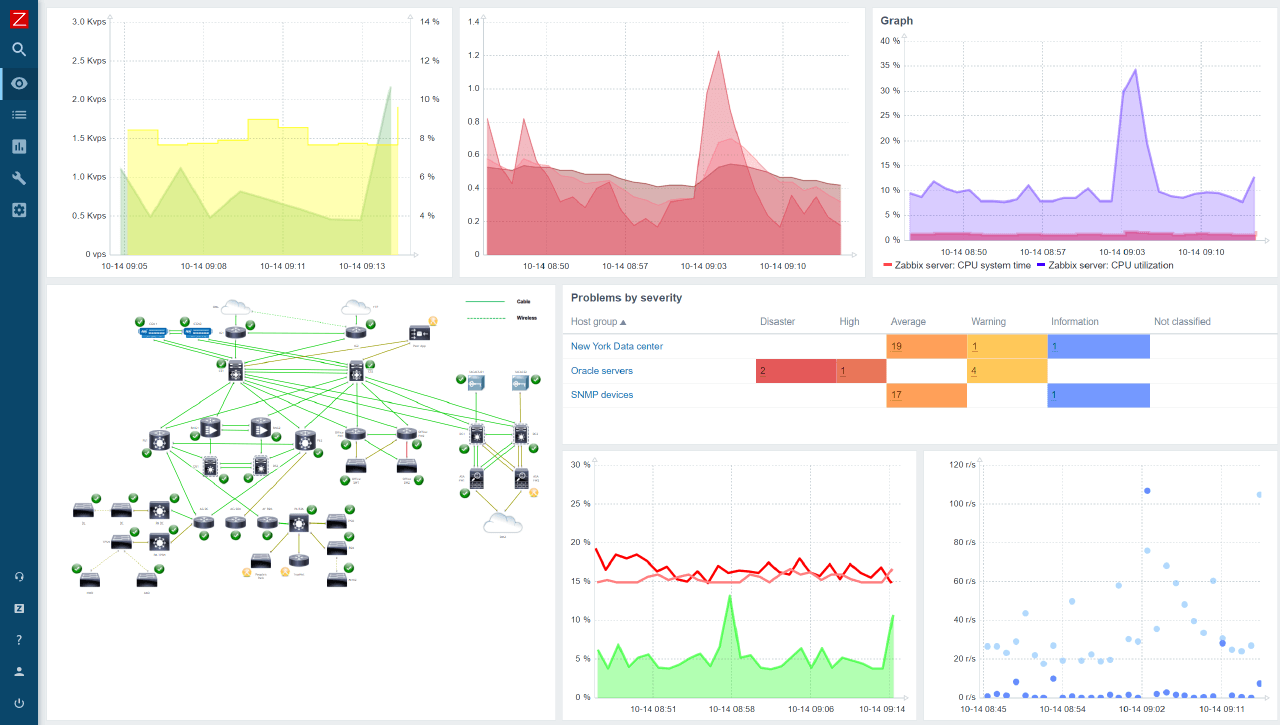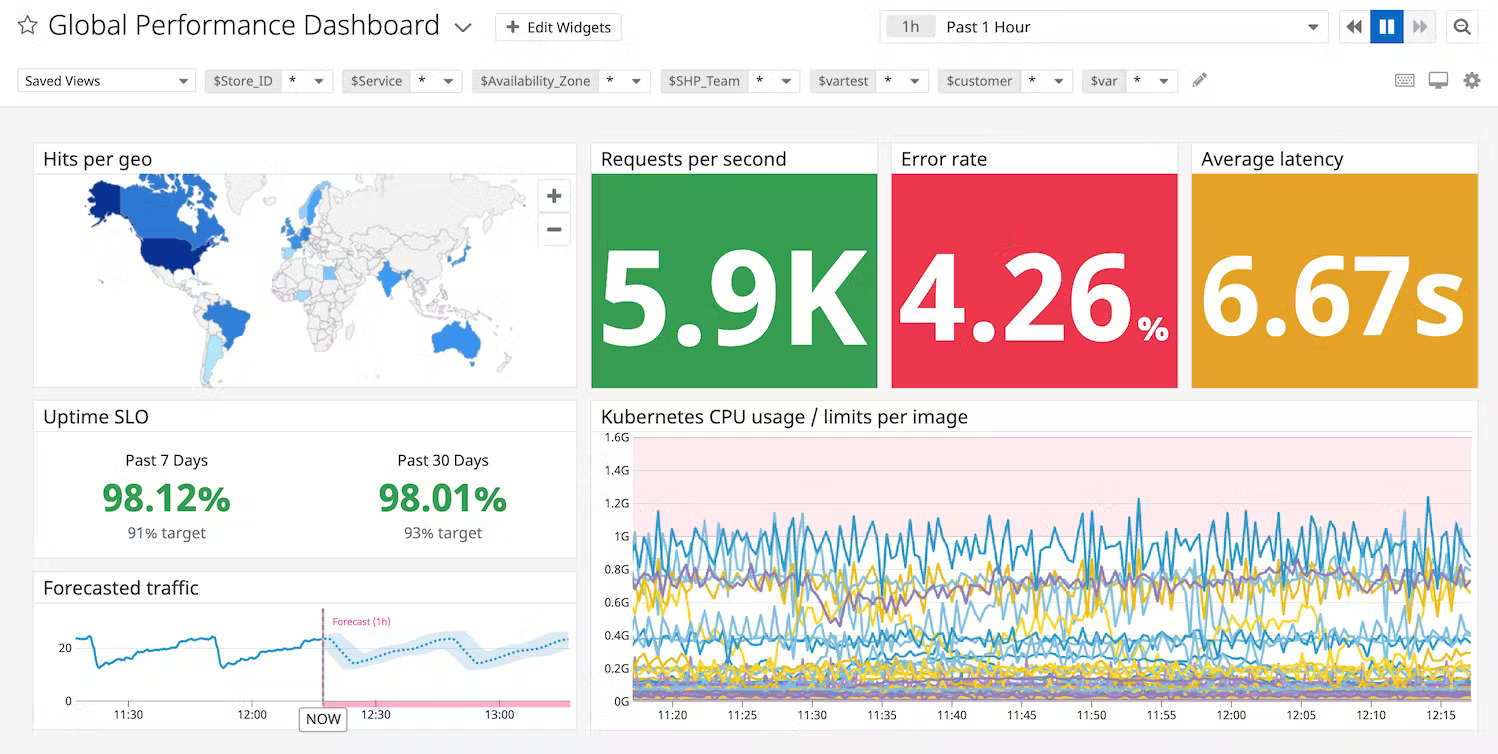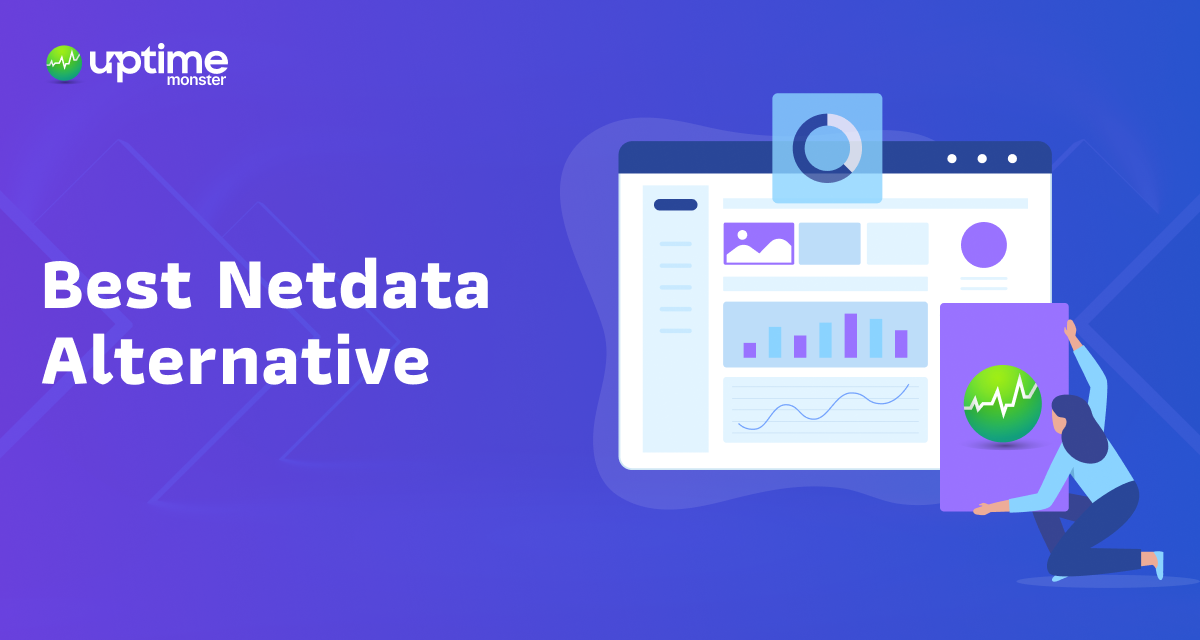
10 Best Netdata Alternative in 2024
Netdata collects metrics every second and displays them in visually appealing, low-latency dashboards. It is crafted to operate seamlessly across your physical and virtual servers, cloud setups, Kubernetes clusters, as well as edge/IoT devices. This allows comprehensive monitoring of your systems, containers, and applications.
Its design incorporates infinite scalability, offering a flexible and highly modular solution. With a user-friendly interface, it is immediately available for troubleshooting without the need for prior knowledge or preparation. Moreover, Netdata seamlessly integrates into existing monitoring toolchains, supporting compatibility with popular solutions like Prometheus, Grafana, Graphite, OpenTSDB, InfluxDB, and others.
Limitations and challenges of Netdata
- While Netdata’s installation process is straightforward, configuring advanced settings and customizations may require a deeper understanding of the tool and the underlying systems.
- Netdata primarily focuses on real-time monitoring, which means it may not retain historical data for extended periods without additional configurations or integrations with external storage solutions.
- While visualizations are good, deeper analysis and reporting features might be lacking for complex needs.
- Alerting features might be less advanced compared to some dedicated monitoring tools.
- Setup/configuration is very hard for the beginner
- Limited reporting/analytics functionalities
- The UI may seem complex for some users.
- Expensive
Best Netdata Alternative
UptimeMonster
Reliable website and server monitoring service from the cloud to monitor your web availability, performance, and security. The tool will give you a 24/7 website monitoring service that will Monitor the availability of your website, APIs, and business-critical web transactions with powerful synthetic monitoring and testing tools.
It collects, correlates, and monitors servers alongside data from the rest of your stack. UptimeMonster server monitoring allows you to visualize, analyze, and track down different query metrics happening on your server so that you can prevent them before anything goes wrong.
Monitor your network performance like IP, DNS, Service port, Application, and others using the check monitoring tools. It will enable you to understand the network behavior and track NetFlow.
UptimeMonster check monitoring service will give you full control over your network. The check monitoring types are as follows
- TCP (Transmission Control Protocol)
- ICMP PING (Internet Control Message Protocol)
- IP Blacklist
- UDP (User Datagram Protocol)
- DNS (Domain Name Server)
- Application Monitoring
With a status page, you can share your monitoring activities and incidents with customers. You can easily make our status page public or private. You can highly customize your status page and share it with your customers to reduce the number of customer support tickets.
Using the status page you can easily gain trust from your customers. The alert notification easily notifies your customers about any incidents so that they can take necessary steps to prevent the issue. So that they will always be prepared and stay tuned.
Create and customize intricate policies for the escalation of incidents by taking into consideration various factors, including the passage of time, the availability of your team, and the source or origin of the incident.
The primary advantage, however, lies in integrated incident management and alerting. This is particularly advantageous for DevOps teams aiming to streamline their stack and potentially handle everything from a unified platform, eliminating the necessity for additional platforms.
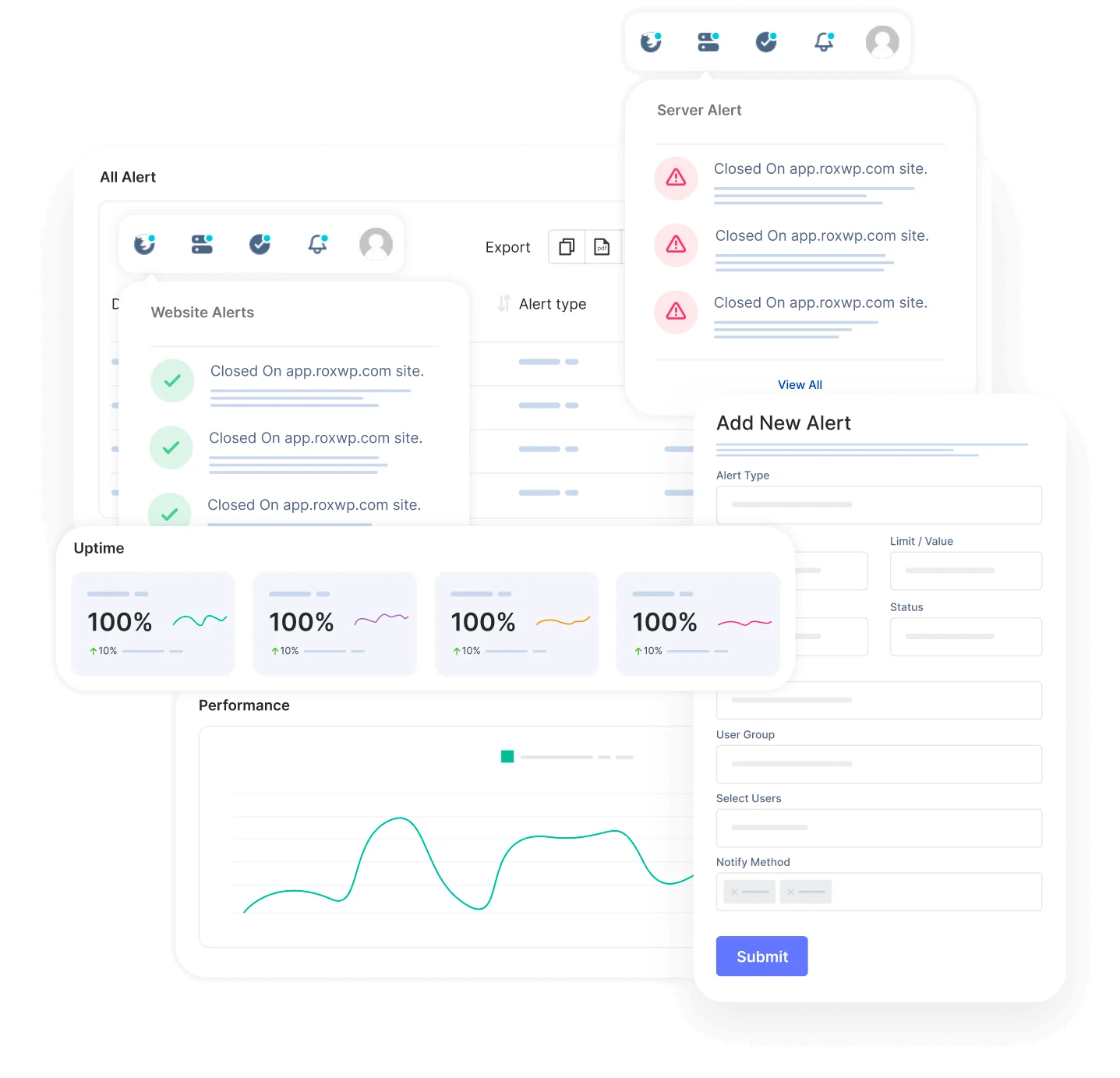
Key Features
- Reliable Website and Server Monitoring
- Network Performance Monitoring
- Check Monitoring Types
- Status Page Customization
- Alert Notifications
- Incident Escalation Policies
- Incident Timeline
- SSL Expiration Monitoring
- Search String Monitoring
- Monitoring for HTTP(s), Ping, Port, DNS, SSL & TLD expiration, Cron jobs
- Unlimited email and push notification alerts
- Capture screenshots & error logs for incidents
Pros
- Reliable Uptime Monitoring
- Easy Setup and Configuration:
- Cost-Efficiency
- Customer Support:
- Accurate Reporting:
- User-Friendly Interface
- Customizable Alerts
- Status Page
- Escalation policies
- Incident Timeline Report
Cons
According to user reviews, UptimeMonster doesn’t exhibit any notable drawbacks. However, a few users have highlighted certain feature limitations present in the free plan offering. These limitations might include restricted access to certain functionalities or reduced capabilities compared to the premium plans. Despite this, the overall consensus from users is overwhelmingly positive regarding the platform’s performance and functionality.
Our perspective on this matter revolves around the notion that smaller teams might not necessitate the utilization of numerous advanced features. Therefore, it appears reasonable to curtail access to certain functionalities, considering that smaller teams might not require or fully utilize these advanced features. This approach ensures a streamlined and more focused user experience, optimizing the platform’s usability for smaller teams with specific needs.
Pricing
- Standard plan at $7/month with 30 monitors and 2-minute interval
- Professional plan at $19/month with 50 monitors and 1-minute interval
- Business plan at $99/month with 100 monitors and 25-second interval
Uptrends
Uptrends is a comprehensive website and server monitoring service designed to ensure your online assets’ continuous availability, performance, and security. With powerful synthetic monitoring and testing tools, Uptrends enables 24/7 monitoring of your websites, APIs, and critical web transactions. The platform goes beyond basic uptime checks, allowing you to collect, correlate, and monitor data from your servers, offering insights into various query metrics to prevent issues before they impact your operations.
Uptrends covers a spectrum of network performance aspects, including IP, DNS, service port, and application monitoring through its check monitoring tools. These tools provide detailed insights into network behavior, allowing users to track NetFlow and gain a thorough understanding of their network’s performance.
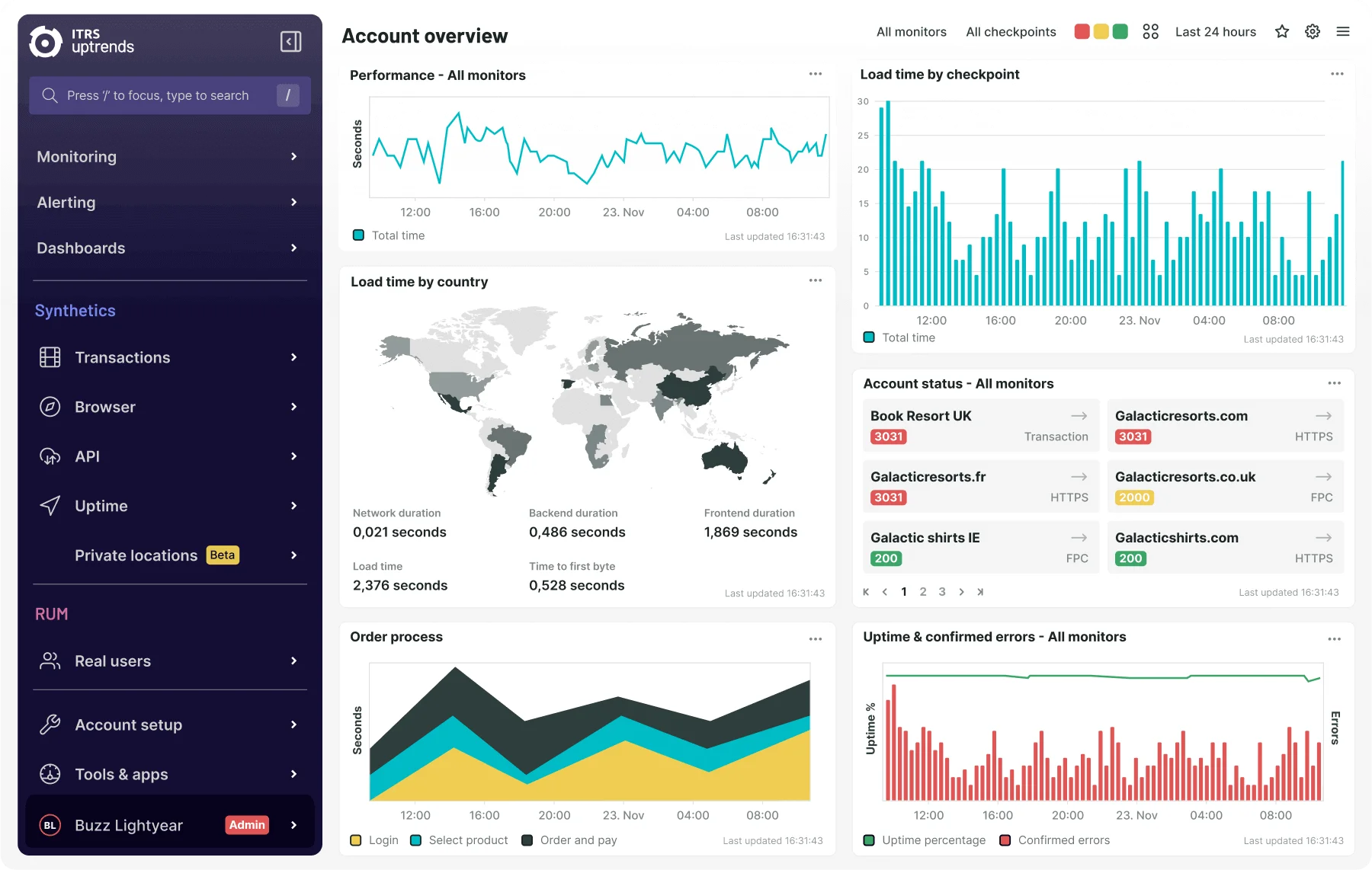
Key Features
- Integration
- Alerting
- Monitoring checkpoint
- Private recorder
- Transaction recorder
- Mobile app
- Public status page
- Custom metrics
- Concurrent monitoring
Pros
- Detailed alerts in case a check fails with error codes
- Available checkpoint
- Supports
- Easy to control multi-user access
- Ease of use
Cons
- The dashboards provide many options, so it can sometimes be confusing to know where to find exactly what you’re looking for.
- It also takes quite some time to set up things properly to avoid alert fatigue.
- Identifying the root cause of an uptrend poses a significant challenge due to its fluctuating nature involving both highs and lows, potentially impacting a business in either a positive or negative manner.
- Expensive
- The timeframes to monitor are not easily defined and implemented.
- Email alert notification charge
Pricing
Business plan starting at $100/month for organizations with fewer than 5 websites, applications, or APIs.
Uptime.com
Uptime.com is so expensive. Besides it doesn’t offer any free package. It also provides unmatched visibility and availability, empowering engineering, operations, and SRE teams to monitor & respond to their most essential services.
The Starter plan starts at $20 per month which includes 20 basic checks, no status page, and groups that are not included in this package. While Uptime.com’s pricing structure may position it as a relatively expensive alternative. It’s essential to recognize the company’s established reputation and consider whether the pricing aligns with the perceived reliability of its systems.
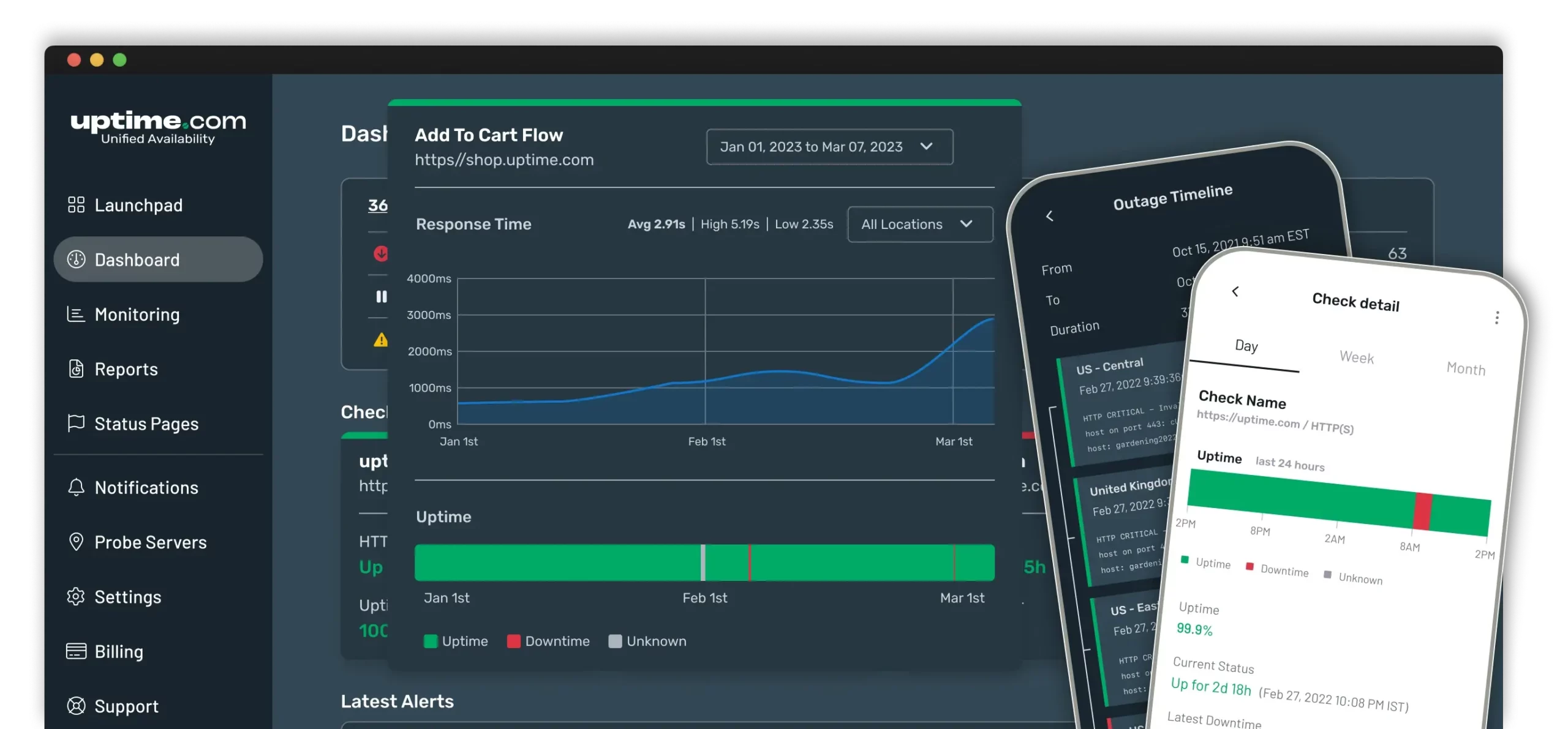 Pros
Pros
- Notifies quickly of any detected issues
- Robust API
- Multiple monitoring locations
- Easy configuration
- Insight reporting
Cons
- More expensive than other tools
- The timeout limit of 60sec on the transactions was a bit difficult to manage for some users
- Fales notification issue if the monitor is not configured properly
- Public status pages could be more configurable
Pricing
- Starter package – $20/month with 20 checks
- Essential package – $67/month with 40 checks
- Premium package – $379/ month with 200 checks
HetrixTools
HetrixTools is an easy-to-use uptime monitoring and blacklist check tool. With Hetrix tools you can select to monitor your website or server from up to 12 different locations around the world. Each one of your Uptime Monitors will have a neatly organized Uptime Report, which will contain all of its history, such as recorded outages, errors, response time, etc. Every Uptime Report is private by default, which means that only you (as a logged-in user) can view it, but you can also choose to make it public and share it with your colleagues or clients.
Every Uptime Monitor comes with detailed reporting, encompassing its entire history, including recorded outages, errors, response times, and more. By default, each Uptime Report is private, ensuring that only you, as a logged-in user, have access. However, you also have the option to make it public, allowing you to share it with colleagues or clients as needed.
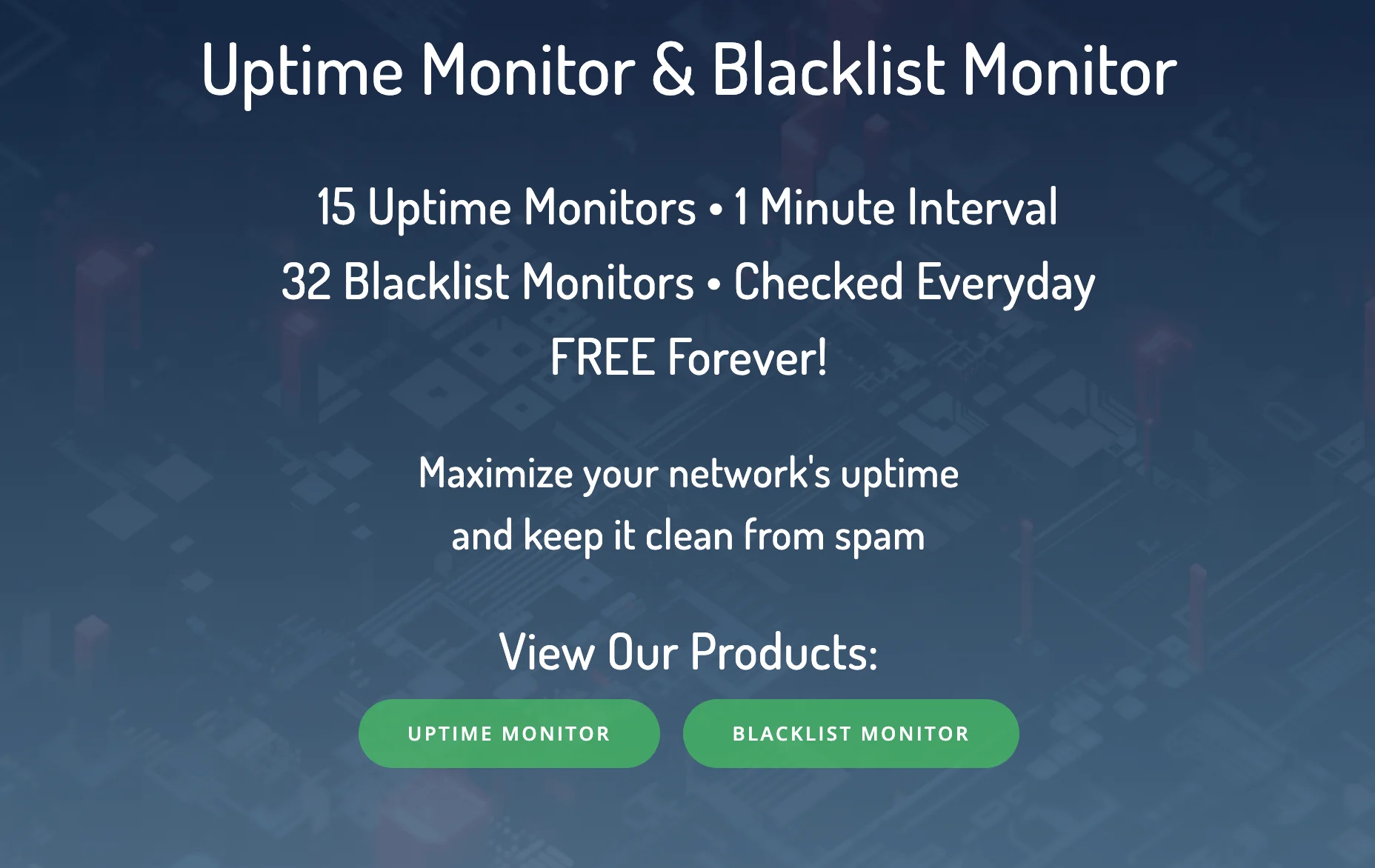
Pros
- Blacklist monitoring
- Customizable alerts and notification
- User-friendly interface
- Reporting
- Pricing
- Geographical monitoring
Cons
- Network problem
- Security issue
- Adaptability
- Customization and flexibility
Pricing
- Professional – $9.95/month
- Business – $19.95/month
- Enterprise – $49.95/month
Zabbix
Zabbix is a powerful, enterprise-grade monitoring solution that keeps a watchful eye on your IT infrastructure, ensuring everything runs smoothly and efficiently. Whether you’re a small business or a large organization, Zabbix provides comprehensive monitoring capabilities to safeguard your critical systems and applications.
Utilizing an extensive range of data collection methods, including JMX, SNMP, WMI, IPMI, and customizable scripts, this software provides a precision-focused approach to network monitoring. It can adapt diverse monitoring requirements, whether in on-premise or cloud environments, catering to networks of varying complexities.
Key Features
- Trend Prediction: Anticipate future trends with Zabbix’s trend prediction feature, enabling proactive measures based on historical performance data.
- Automated Problem Resolution: Zabbix streamlines operations with automated problem resolution, minimizing manual intervention and ensuring swift responses to detected issues.
- Anomaly Detection: Uncover irregularities in your network’s behavior using Zabbix’s anomaly detection, providing early insights into potential performance deviations.
- High-Level Map Navigation: Gain a comprehensive understanding of network structure and dependencies through Zabbix’s high-level view with map navigation, offering a visual representation of your network landscape.
Zabbix seamlessly integrates with a diverse array of IT infrastructure components, fostering compatibility and interoperability:
- Database Harmony: Collaborate effortlessly with databases, as Zabbix aligns smoothly with MySQL, PostgreSQL, and Oracle, ensuring seamless data synchronization.
- Cloud Compatibility: Embrace cloud services without constraints—Zabbix extends its capabilities to work seamlessly with cloud giants such as AWS and Azure, providing holistic cloud monitoring.
- Interconnectivity with Monitoring Tools: Forge connections with other monitoring tools effortlessly, as Zabbix harmonizes with popular solutions like Grafana and Elasticsearch, offering a unified and synergized monitoring ecosystem.
Pros
- Versatile Data Collection Methods
- Scalable to Large Networks
- Open-Source and Cost-Effective
Cons
- Steeper Learning Curve
- GUI Could Be More Intuitive
- Requires In-House Expertise for Setup and Maintenance
Pricing
- Zabbix Core: Free and open-source, ideal for individuals, small businesses, and non-profit organizations.
- Zabbix Enterprise: Paid version with additional features like enhanced security, distributed monitoring, and high availability. Pricing depends on the number of monitored items and licenses.
- Zabbix Professional Support: Optional paid support plans for Zabbix Core and Zabbix Enterprise, offering faster response times, technical expertise, and access to exclusive resources.
ICINGA
Icinga, an open-source network monitoring tool, delivers adaptable and scalable solutions for monitoring network resources, notifying users of outages, and supplying data for reporting purposes. Renowned for its extensible architecture, Icinga is an ideal choice for environments seeking a monitoring solution that is both customizable and scalable to their specific needs.
Its capability to seamlessly adapt to the expansion of an organization’s network and its capacity to integrate with a plethora of plugins and add-ons for enhanced functionality showcase its versatility.
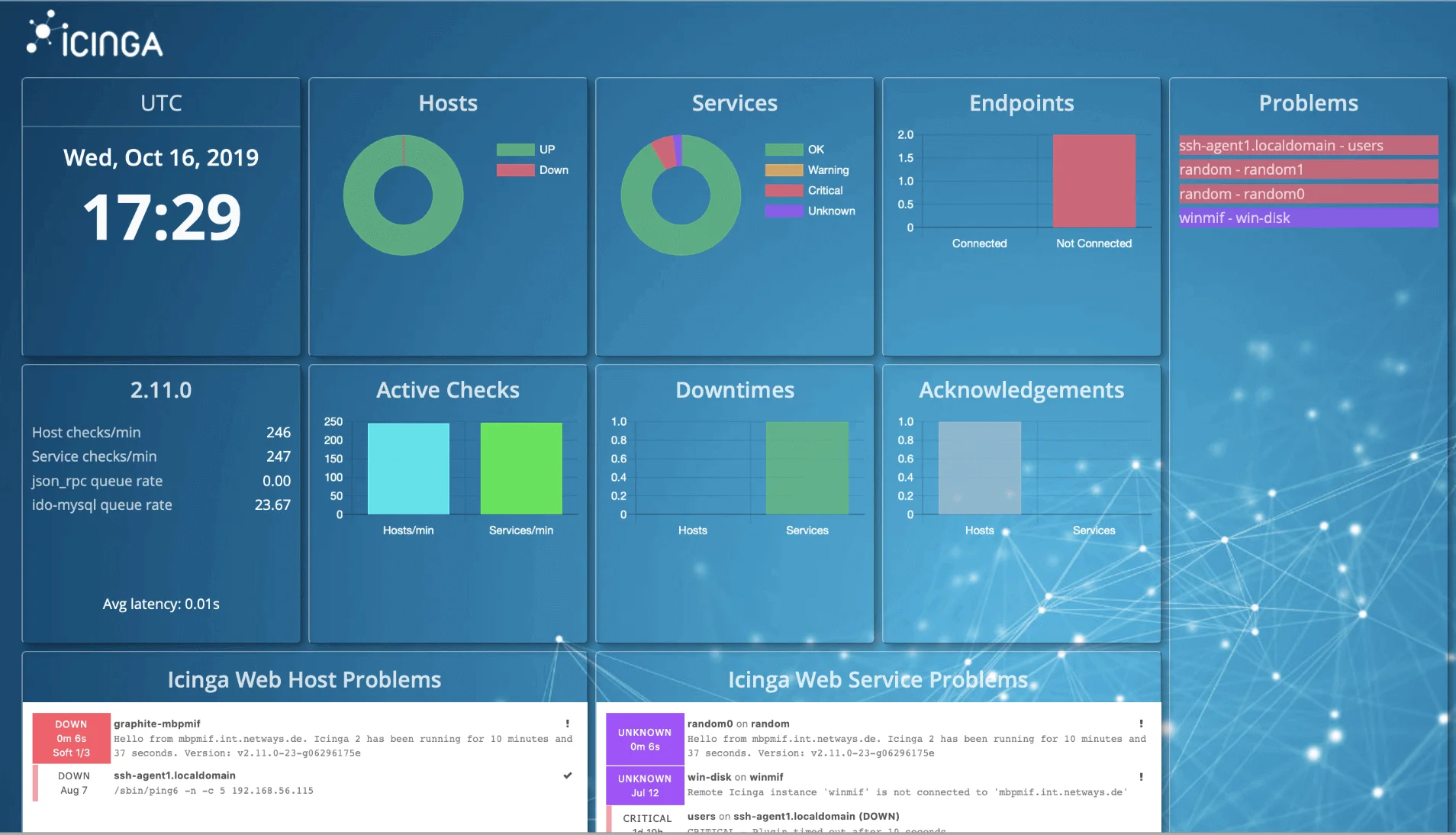
Key Features
- Real-Time Network Monitoring: Icinga excels in real-time network monitoring, providing instant insights into the health and performance of critical network resources.
- Multi-Channel Notifications: Stay informed with notifications delivered through various channels, ensuring prompt alerts for any detected issues, and allowing for quick response and resolution.
- Puppet Integration for Automation: Strengthen your network monitoring capabilities with integrations like Puppet for IT automation, enabling automated responses to identified issues and streamlining operational workflows.
Pros
- Open-source and Cost-effective
- Highly Flexible and Customizable
- Alerting and Reporting:
- Active Community and Support
- Lightweight and Scalable
Cons
- Initial Setup Complexity
- Documentation could be improved
- Interface can feel outdated
Pricing
As an open-source tool, Icinga is freely available for use. Besides, if your needs extend to enterprise-level features and dedicated support, Icinga provides commercial packages, and details regarding their pricing can be acquired through inquiry.
DataDog
Datadog’s website monitoring stands out as a comprehensive solution that offers unparalleled visibility. It goes beyond mere aggregation by seamlessly collecting metrics and events from an extensive range of over 500 integrated technologies, tagging and storing them for further analysis.
Notably, Datadog streamlines the entire process by taking care of the ingestion, normalization, and enrichment of logs, allowing users to focus on deriving meaningful insights rather than grappling with technical intricacies. This ensures a user-friendly experience and maximizes the efficiency of log management operations.
Furthermore, Datadog doesn’t stop at threat identification; it actively tracks the performance impact of every deployed code. This automated tracking extends to mapping data flows and dependencies through a service map, offering a visual representation of the intricate relationships within the infrastructure. By doing so, Datadog not only ensures robust security but also provides valuable insights into the operational dynamics of the entire system.
Checkmk
Checkmk caters to diverse infrastructure needs, from small business networks to sprawling enterprise environments. It features extensive monitoring capabilities, flexible customization, and strong community backing.
Checkmk offers comprehensive monitoring solutions for networks, servers, applications, and clouds. It is available as an on-premises package for Linux or Docker, with an appliance version also provided. Additionally, there is a version tailored for managed service providers. The system incorporates autodiscovery, asset inventory creation, and a network topology map.
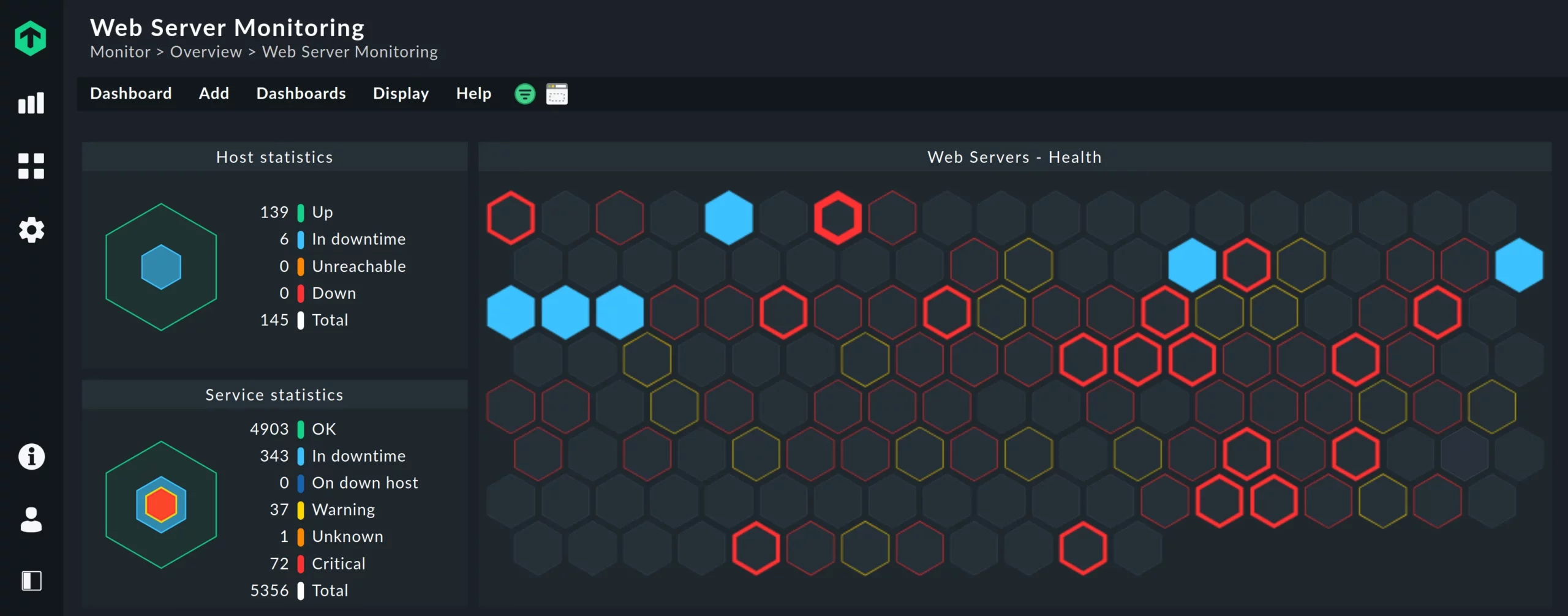
Key Features
- Comprehensive IT Monitoring
- Flexible Customization
- Scalability and Growth
- Extensive Plugin Ecosystem
- Powerful Alerting System
- Strong Reporting and Analytics
- Open-Source Core
Pros
- Suitable for security surveillance
- Flexible searches within real-time event data
- Automatic identification of IT assets
- Scalable and Adaptable
Cons
- Less Intuitive Interface
- Only for Linux and Docker
Atera
Atera is a cloud-based platform that brings together a comprehensive suite of IT management tools under one roof. It caters specifically to Managed Service Providers (MSPs) and internal IT teams, aiming to streamline operations, boost efficiency, and deliver exceptional customer service.
This cloud-based solution offers a unified suite of tools for remote monitoring and management (RMM), professional services automation (PSA), and remote access. Atera streamlines IT workflows, providing real-time insights into network performance, security, and device health. With features like automated ticketing, patch management, and remote support, Atera empowers IT professionals to efficiently manage and optimize their clients’ systems, ensuring proactive and responsive services.
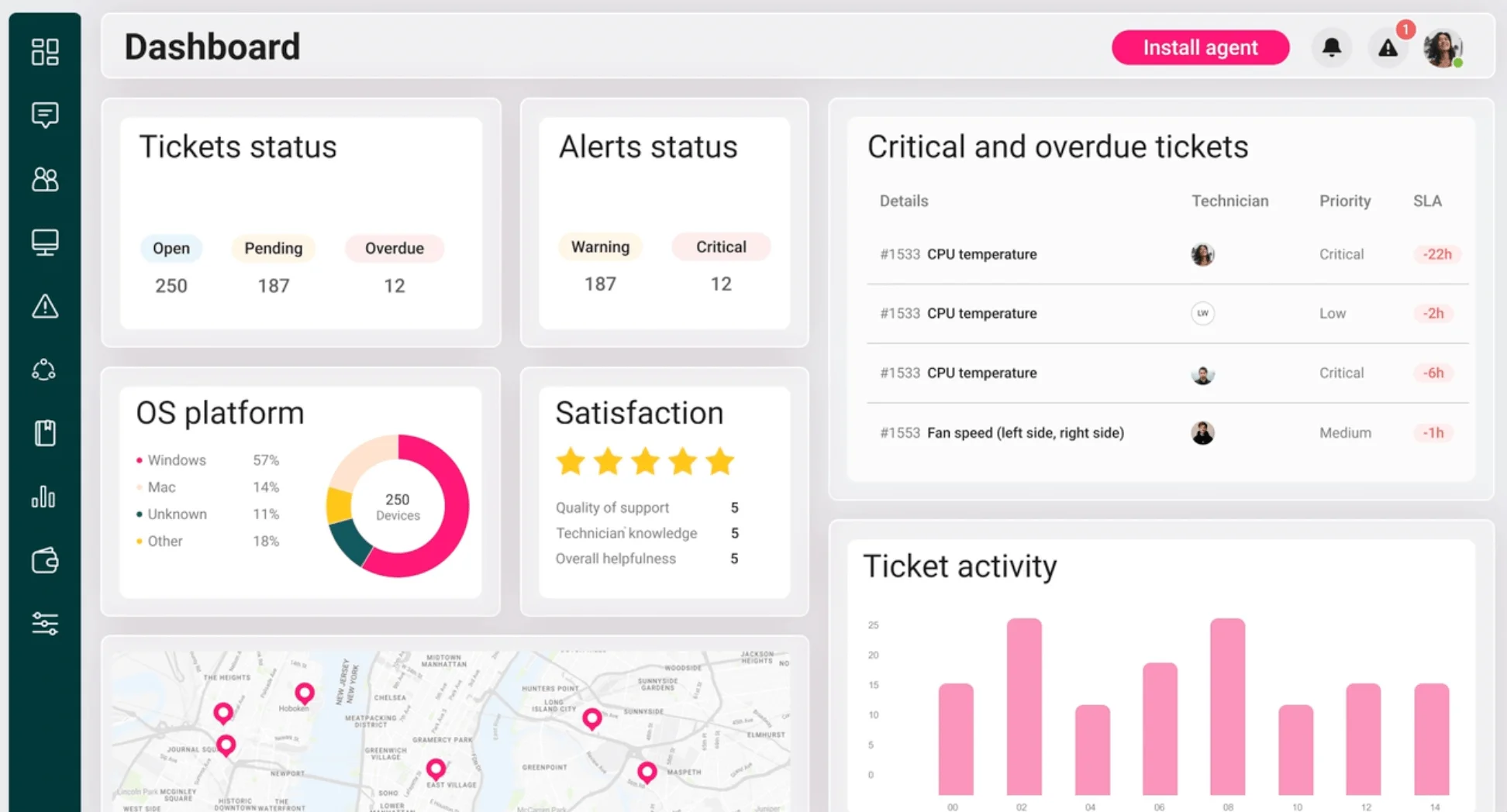
Key Features
- Remote Monitoring and Management (RMM)
- Professional Services Automation (PSA)
- Remote Access
- Network Monitoring
- Automated Ticketing
- Patch Management
- Proactive Alerts and Notifications
- Backup and Recovery
Pros
- Multi-tenanted architecture for versatile usage
- Empowers each support technician to manage multiple clients efficiently
- Incorporates automated patch management for streamlined updates
- Features remote access and remote desktop utilities for enhanced accessibility
Cons
- Mobile app functionality is not as robust as the web version
- Occasional delays in ticket notifications
- The difficult learning curve for beginner
- Network topology mapping requires an additional cost.
Pricing
- The Basic plan starts at $149/ month
- The Expert plan starts at $169/ month
- The Master plan starts at $199/ month
Elastic Stack
Elastic Stack, formerly known as ELK Stack, is a powerful collection of open-source tools designed for searching, analyzing, and visualizing large volumes of data in real time. Comprised of several components, each with its unique functionality, Elastic Stack provides a comprehensive solution for various data management and analysis tasks.
At the core of Elastic Stack is Elasticsearch, a distributed search and analytics engine. It stores and indexes data in near real-time, enabling fast and efficient searching across massive datasets. Elasticsearch is highly scalable, fault-tolerant, and supports complex querying capabilities.
Logstash is a versatile data processing pipeline that ingests, transforms, and enriches data from multiple sources before indexing it into Elasticsearch. It supports a wide range of input sources, including logs, metrics, and event streams, and offers extensive filtering and parsing capabilities.
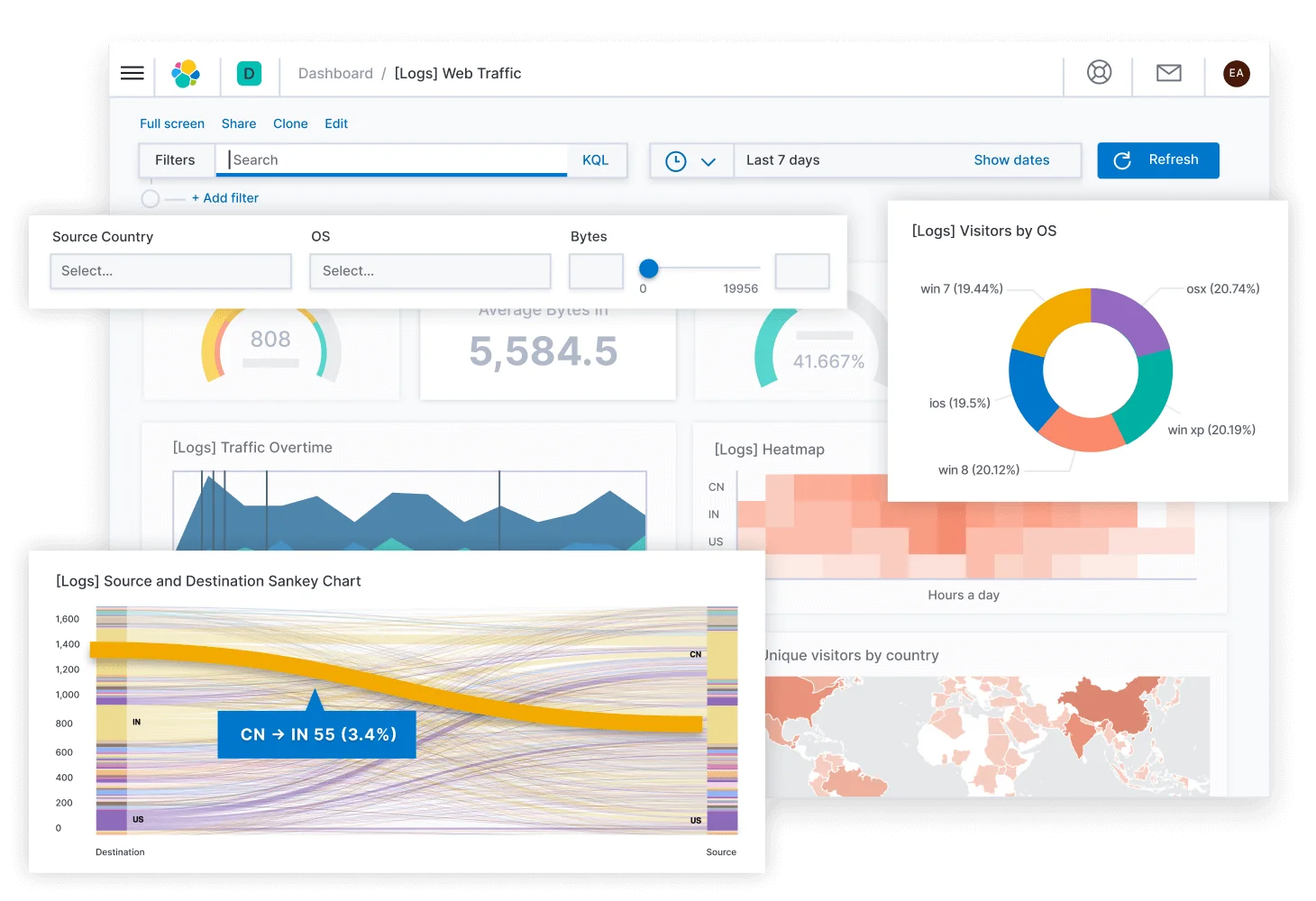
Key Features
- Open-source and cost-effective: The core functionality is free to use, making it budget-friendly for various needs.
- Scalable and flexible: Adapts to accommodate growing data volumes and diverse use cases.
- Real-time insights: Gain instant visibility into your data, enabling proactive decision-making.
- Powerful search and analysis: Explore and analyze data with precision using Elasticsearch’s robust capabilities.
- Stunning visualizations: Kibana empowers you to create impactful dashboards and reports for clear communication.
- Active community and support: Benefit from a vibrant community offering resources and assistance.
Pros
- Scalability
- Real-Time Data Processing
- Versatility
- Open-Source
- Comprehensive Toolset
Cons
- Complexity
- Resource Intensive
- Learning Curve
- Maintenance Overhead
- Documentation Gaps
- Licensing Considerations
Pricing
- Standard package starts at $95/month
- Gold package starts at $109/month
- Platinum package starts at $125/month
- Enterprise package starts at $175/month
Wrapping Up
Navigating through the abundance of alternatives to Netdata requires careful consideration to ensure effective monitoring and observability in a production environment. Selecting the right tool for proactive management is crucial. While Netdata offers impressive capabilities, it encounters obstacles such as outdated documentation, complex pricing structures, and a convoluted user interface.
Exploring substitutes for Netdata presents an opportunity to better fulfill your monitoring needs. When evaluating alternative options, it’s essential to take the following factors into account:
- Cost: Seek solutions with transparent and predictable pricing to avoid unexpected expenses like overage penalties.
- Support: Prioritize tools with robust customer support and a thriving community, particularly during the transition to a new platform.
- Open-Source: Although not obligatory, an open-source tool provides transparency and customization options for developers.
- OpenTelemetry Support: Tools integrated with OpenTelemetry, such as SigNoz, align with evolving standards for cloud-native application instrumentation.
- Data Security and Compliance: Ensure that the chosen tool complies with data privacy and security standards, especially concerning sensitive information.
- Trial Period and Transition Ease: Consider tools that offer a trial period and facilitate a seamless transition from New Relic.
In this context, UptimeMonster emerges as an appealing alternative to Netdata, offering comprehensive features and transparent pricing policies.
